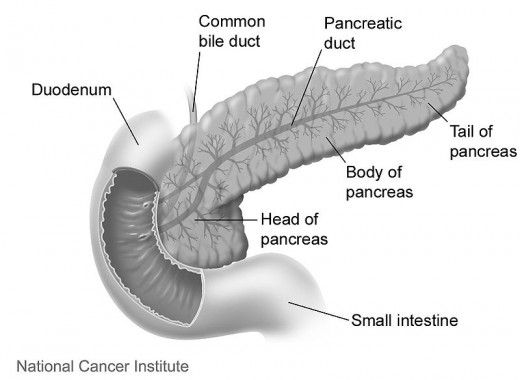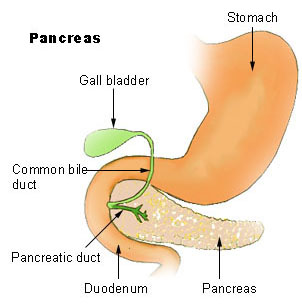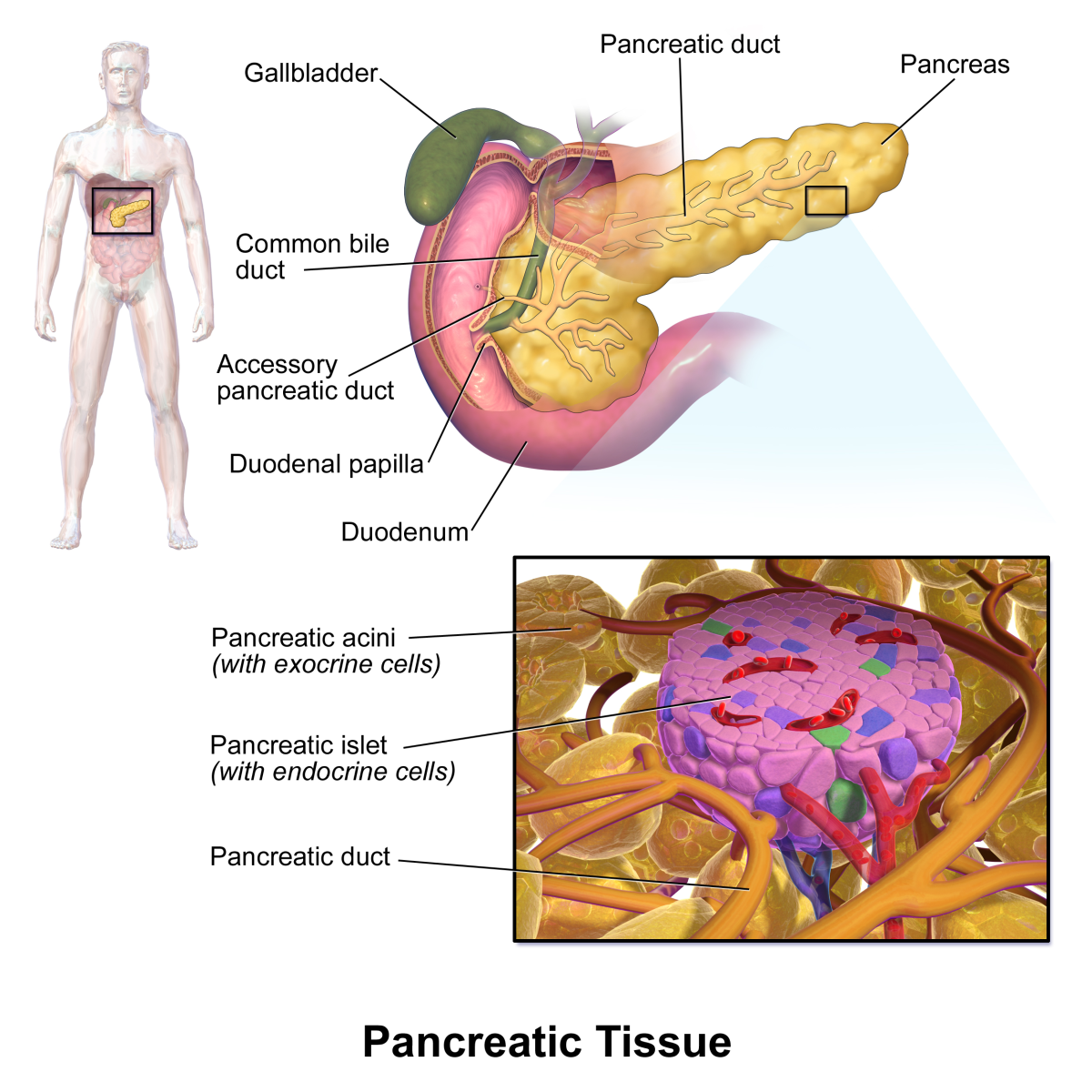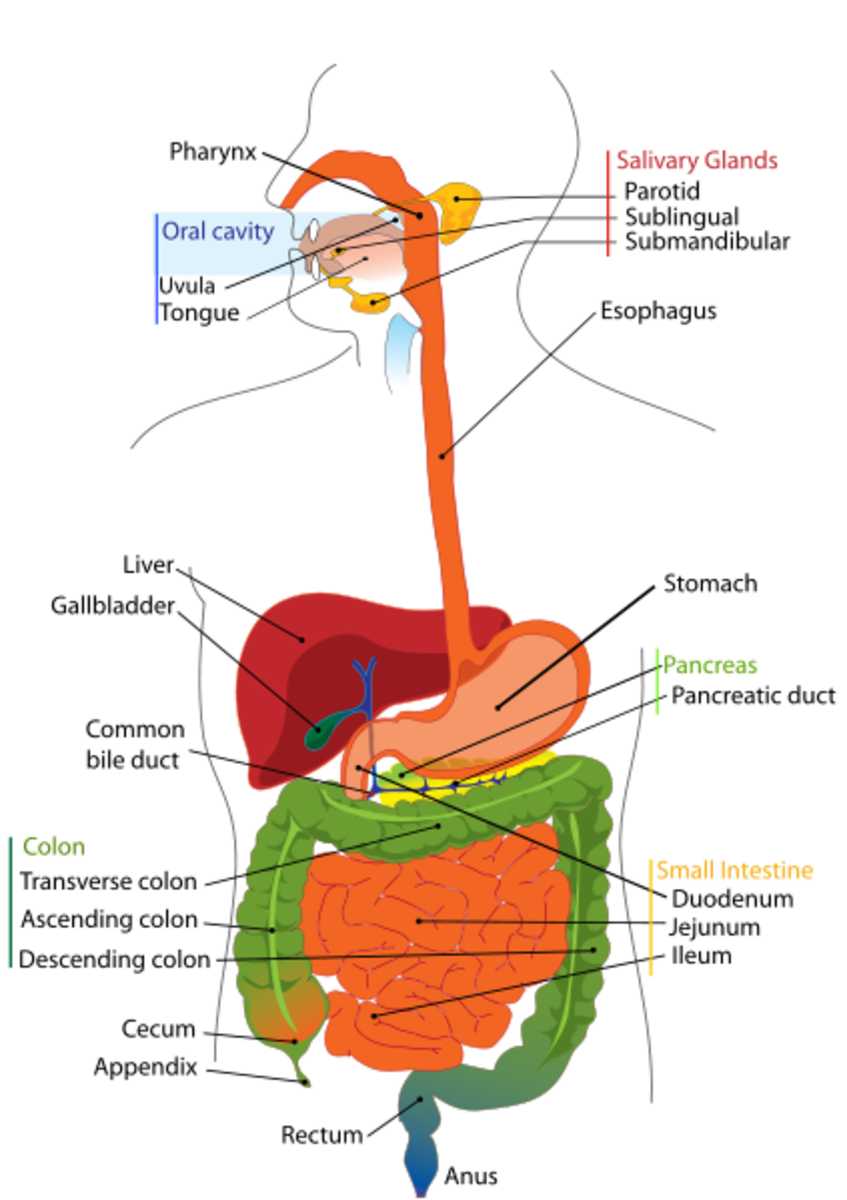Understanding The Pancreas - An Overview

Basics about the pancreas.
The pancreas is a very important gland in the body. The word 'pancreas' comes form the Greek language and means 'all flesh' This is vague term that doesn't really describe the pancreas well.It's about 15/16cm (6/7 inches) long or sometimes described as about the length of your hand. It's situated in the upper left portion of the abdomen - at about the level where your breastbone and ribs meet and lies just behind the stomach.
The pancreas is small but essential for our overall health and uniquely is both an endocrine and exocrine gland:
- Exocrine gland - secretes substances through a series of ducts - or channels - before reaching their target area. For example the pancreas will release pancreatic juices which will eventually go into the duodenum (the first part of the bowel after the stomach) to help with digestion of proteins found in the food swallowed. The pancreas and duodenum are connected by a small tube that runs from the pancreas into this area of the bowel.
- Endocrine gland - secrets chemicals and hormones directly into the blood stream.
The right side of the pancreas is the widest and often referred to as the head of the pancreas. The left side is tapered and is called the body of the pancreas.

Did You Know?
- That when we reach the age of 70 the body produces half the amount of enzymes it did at age 20.
- The National Academy of Sciences, USA have discovered that the pancreas has 'taste receptors'. They are designed to detect glucose in the blood and when this happens the hormone insulin is released. Insulin helps to control blood sugar levels within healthy limits.
- It's possible to live without the pancreas provided the person takes both insulin and pancreatic enzymes that help with digestion.
- Before the function of the pancreas was discovered it was believed that - due to its rubbery construction - it was a shock absorber to prevent the stomach being damaged against the vertebral column.
The functions of the pancreas.
In medical science the role of the pancreas is divided into two main functions:
- Digestive function
- Hormonal function - helps to regulate the body's use of food for energy.
Digestive Functions
In order to help digest our food the pancreas produces enzymes. The main ones are lipase, amylase and proteases. If you look at the table below, this demonstrates what the enzymes are and their functions.
These enzymes are essential for breaking down the food into substances that the body can easily absorb - in other words, digestion. Enzymes are biological catalysts. A catalyst is a substance that causes other substances to change without itself being altered. Therefore, enzymes perform a number of functions in the body - including digestion - but are not themselves changed. About 90% of the pancreas functions are to do with digestion. The enzymes responsible for aiding digestion are made in specialised areas of the pancreas known as the acinar cells.While being stored within the pancreas, the enzymes are in an inactive form so that they don't digest the pancreas itself.
When the pancreas is healthy, it will produce approximately eights cups of pancreatic juice per day and release it into the duodenum. This juice creates the proper environment needed by the enzymes to work effectively.
The duodenum is the first part of the small intestine and receives partly digested food from the stomach. It's the mixture of food and gastric juice entering the duodenum that stimulates the pancreas to release its enzymes. Further down the duodenum the nutrients from the food we eat begin to be absorbed into the body.
Enzyme
| What it does
|
|---|---|
Pancreatic Amylase
| Breaks down carbohydrates into sugars as they are more easily used by the body in sugar form. You will also find amylase in your saliva.
|
Pancreatic Proteases (trypsin and chymotrypsin)
| This enzyme breaks down the proteins we take in our food. This enzyme also helps to protect our gut from infestation by organisms such as protozoa, yeasts and bacteria.
|
Pancreatic Lipase
| Breaks down fat molecules and works in conjunction with the bile from the liver for this purpose. Fats need to be broken down so that the body can absorb them.
|


Did you know?
- Insulin works in exactly the same way for various animals such as nematode worms, fish, mammals and that includes humans.
- The reason that insulin has to be injected and not taken by mouth is that the stomach acid would destroy it.
Hormone functions of the pancreas
Although essential for health only about 5-10% of the pancreas is involved with making hormones. These chemical messengers filter directly into the blood stream from the pancreas. The hormones are made in specialised cells found in many areas of the pancreas. They resemble little islands of cells and these areas are know as the islets of Langerhans. There are about one million of these cells in the adult pancreas. There are several hormones made by these cells:
- Gastrin
- Somatostatin
- Glucagon
- Insulin
Gastrin is a hormone that helps the digestion of food in the stomach
Somatostatin this hormone helps to control the release of other hormones
Glucagon works with insulin to keep the levels of blood sugars balanced
Insulin helps to regulate the levels of sugar in the blood stream
Probably the best known of the pancreatic hormones are insulin and glucagon - especially in relation to diabetes. The word insulin comes from the Latin word insula meaning islands. This refers to the islets of Langerhans in the pancreas as discussed previously. Insulin helps to regulate the amount of sugar in the blood and body cells. The most readily available form of sugar is glucose and insulin is needed to take the glucose from the blood into the body cells where they are used for energy.
The hormone glucagon is also essential in ensuring blood glucose levels remain stable. Glucagon helps by stimulating cells in the liver to release stored glucose, when the levels of this sugar become too low in the blood. When blood sugar levels become high once more insulin is released, taking the sugar out of the blood into the cells. The blood sugar levels then begin to drop and this stimulates the pancreas to release glucagon that again stimulates the liver to release glucose and so the cycle continues.
I hope you've enjoyed this brief overview of the pancreas and the complex actions that it performs. Now when you hear anything about this fascinating area of the body you can be confident of knowing much more about it.









